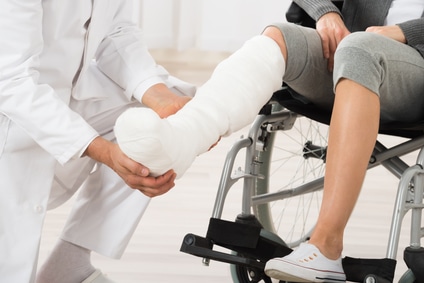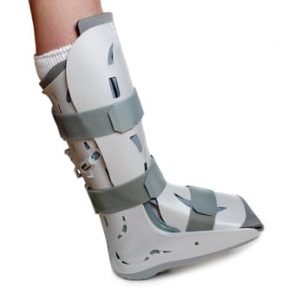Many people suffer ankle injuries doing their job. These injuries occur when you trip or slip on something on the ground. Forklifts and other vehicles can also cause ankle injuries.
A lot of people do not realize how difficult it can be to recover from a serious ankle injury. Pain from this type of injury will probably makes it difficult to stand, walk, or squat. These activities can become even more difficult if you have to work on uneven ground like a construction site.
Different types of ankle injuries
Twisted or sprained ankles are fairly common injuries, especially if you play sports. Fracture are fairly common injuries as well. People often sprain or fracture their ankle when they step in a hole, trip, or slip.
In workers’ compensation, many people suffer crush injuries to their ankles. Sometimes, these injuries occur when tire from a vehicle runs over your leg. These injuries also occur when a safety feature fails on a machine and your leg gets stuck.
How do I get medical treatment for an ankle injury at work?
When you suffer any type of work injury, the first thing you should do is tell your employer. Georgia law requires you to give notice of your injury.
What happens next will depend on how serious the injury is. With a serious ankle injury, you may need to go directly to the hospital for emergency treatment.
If you do not need emergency treatment (or after you get that emergency treatment), you should find out who is on your employer’s panel of physicians.
Most often, you will need to see an orthopedic doctor with an ankle injury. The employer’s panel of physicians have at least one orthopedic doctor listed. It may have more than one.
You could choose an orthopedic doctor off the panel of physicians. You could also decide to choose a different doctor. Remember that the doctor that you choose as your authorized treating physician off the panel of physicians can refer you to a specialist if needed.
What medical treatment will I need for my ankle injury?
The answer to this question depends on the type of injury you suffer. Your doctor should determine the best medical treatment for you. The doctor will need to diagnose your specific injury to determine the best treatment.
Doctors usually diagnose your injury by performing a clinical exams and ordering diagnostic testing. You will almost certainly have x-rays after a serious ankle injury. X-rays help the doctor determine if you have a fracture.
Sometimes, the doctor will need to order other diagnostic tests. For example, doctors often order MRIs which help the doctor see things that do not show up on x-rays.
The treatment recommended by the doctor will usually depend on the doctor’s diagnosis. Some common treatments for serious ankle injuries includ:
- Physical therapy
- Braces and other assistive devices
- Medication to reduce pain and inflammation
- Injections to relieve pain
- Surgery
What if the medical treatment does not completely cure my ankle injury?
Hopefully, seeing a good doctor and getting medical treatment will help you fully recover. But, some people do not.
Serious ankle injuries often cause pain and swelling that never gets completely better. I have seen this most often when my clients suffer crush injuries. If an ankle injury continues to cause you problems, your doctor could refer you for pain management treatment.
One difficulty that you could face if you need long term medical treatment is the change in the workers compensation law that limits medical treatment to 400 weeks in most cases. If you want to learn more about that change, I discuss it in detail in this article.
If you do not have a full recovery from your injury, your doctor should also give you a permanent partial disability (PPD) rating. This rating entitles you to receive PPD benefits for your injury. If your are receiving temporary total or temporary partial disability benefits, the PPD benefits will not start until those benefits stop.
 What if I will have difficulty returning to work?
What if I will have difficulty returning to work?
Many jobs require you to spend almost the whole day standing or walking. People who work in construction, warehouses, retail stores, and restaurants spend almost the whole day on their feet.
When you have an ankle injury, it can be very difficult to stand or walk for a long time. If you work in a job that requires you to drive a lot and use a clutch, you will probably have difficulty doing that as well.
Your workers compensation doctor should address your work status. The doctor may tell you to stay out of work completely or may place work restrictions on you.
Even if you are placed on restrictions, your workers compensation benefits typically continue unless your employer offers you a suitable job or you go back to work on your own. Georgia’s workers compensation law has special rules about light duty job offers. If you want to know about those special light duty rules, take a look at this article.
What sort of work restrictions can I expect for an ankle injury?
This will depend on the severity of your injury. Some of the common restrictions that doctors order include:
- Sit down work only
- Limit standing to a certain number of hours
- Alternate between sitting and standing
- No or limited squatting
- No or limited climbing of ladders and stairs
- No working at heights
- Limited lifting
- The need to elevate your leg every so often to reduce swelling
The particular restrictions for your injury will depend on the severity of your injury and your doctor’s recommendations. Also, your restrictions may change with time if your injury improves or worsens.
Sometimes, the limitations from your injury may prevent you from ever returning to the work you did. If you cannot go back to work, the insurance company will probably have to keep paying you temporary total disability benefits. But, these types of injuries can be especially difficult since Georgia has some limits on how long you can received workers compensation benefits in most cases.
How long does workers’ compensation have to pay benefits for an ankle injury?
In most workers compensation cases, both your medical benefits and your wage loss benefits “automatically stop” 400 weeks after you injury. 400 weeks is a cap. Your benefits can also stop much sooner than that.
400 weeks seems like a very long time. But, it is not necessarily long enough if you suffer a serious injury that will make it difficult or impossible to return to work.
Georgia’s workers compensation law does have exceptions to these 400 week caps. The primary exception is a catastrophic designation.











